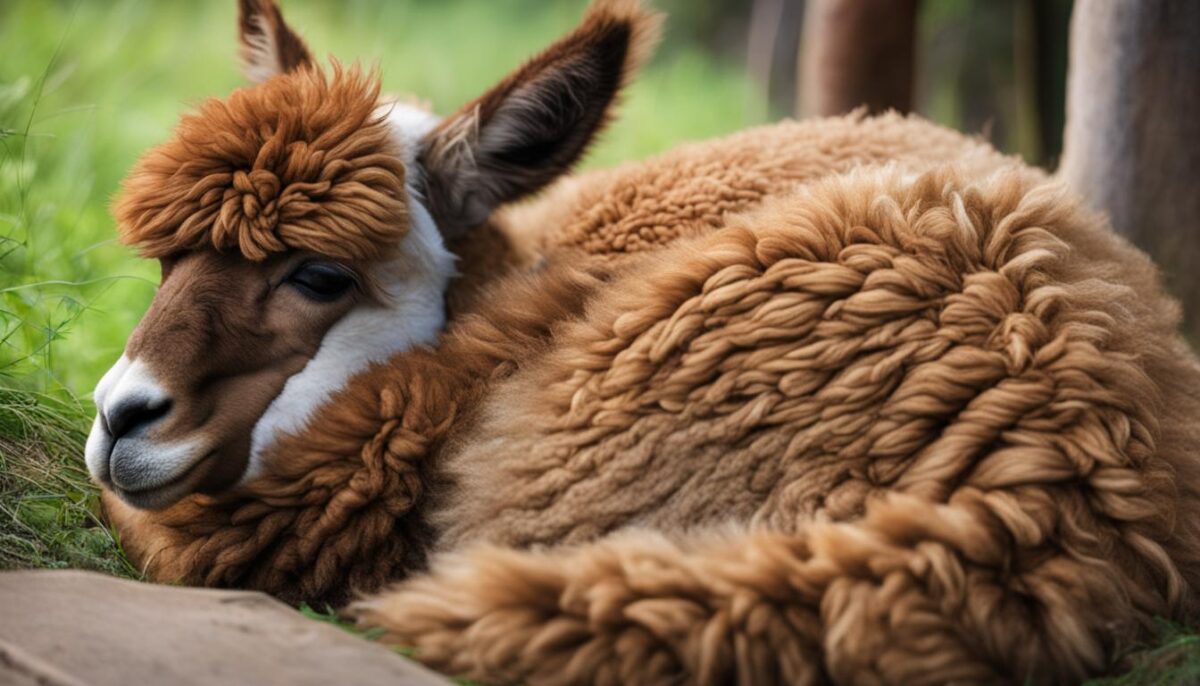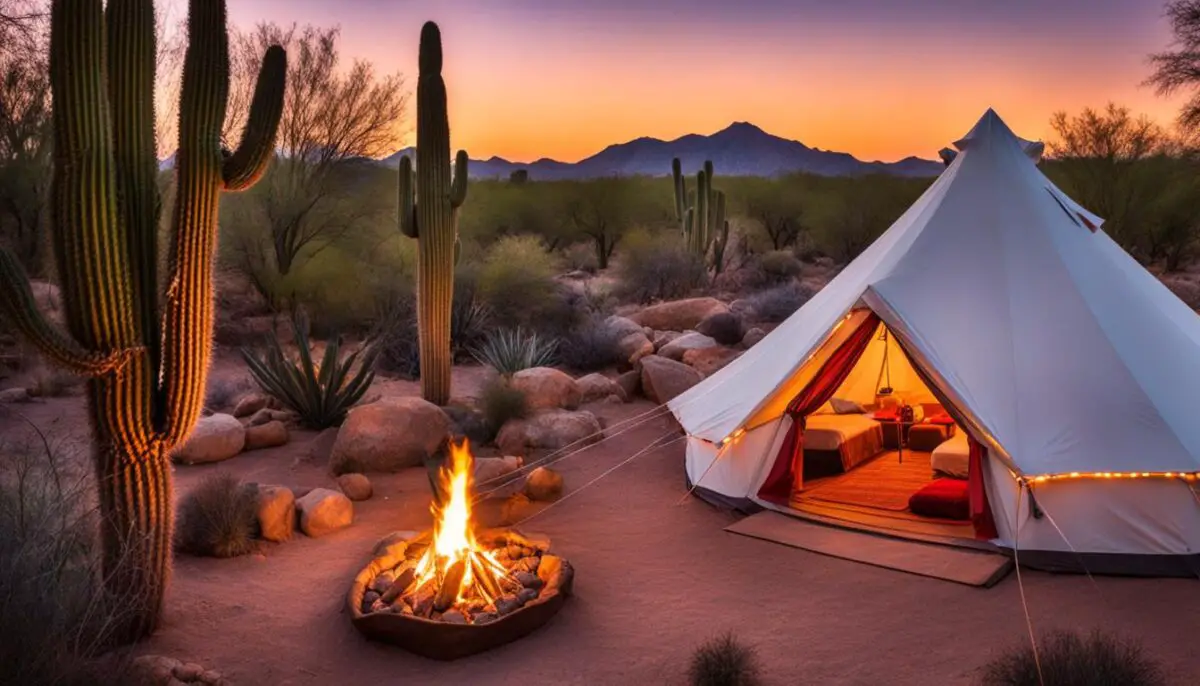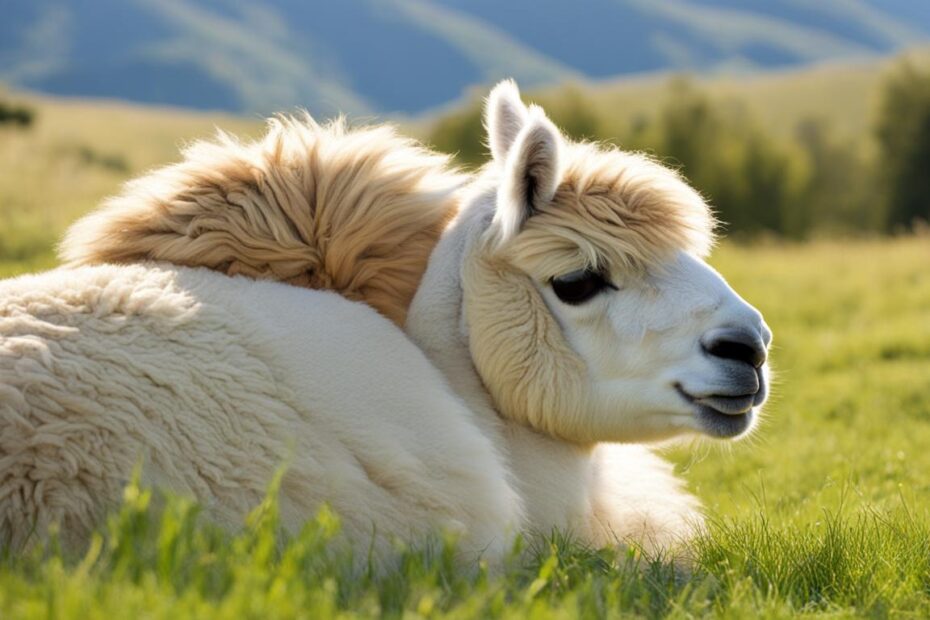Alpacas are captivating creatures, and their sleeping habits add to their unique charm. Understanding their sleep patterns can provide insight into their behavior and characteristics. Alpacas sleep in a standing position, often in groups, and take short naps throughout the day. They have a light sleep cycle and are always aware of their surroundings, making them vigilant and alert even while resting.
Key Takeaways:
- Alpacas sleep in a standing position, often in groups.
- They have a light sleep cycle and are always aware of their surroundings.
- Alpacas take short naps throughout the day.
- Understanding alpaca sleep patterns can provide insights into their behavior and characteristics.
- Creating a suitable sleep environment is essential for their well-being.
Alpaca Sleep Habits and Positions
Alpacas have distinct sleep habits and positions that contribute to their unique sleeping patterns. They are known for sleeping in a standing position, with their eyes partially closed. This allows them to quickly respond to any potential threats in their surroundings. Alpacas also take short naps throughout the day, ranging from a few minutes to a couple of hours.
Although alpacas predominantly sleep while standing, they may occasionally lay down to sleep, especially during longer periods of rest at night. This alternating between standing and laying down helps them maintain their sleep cycle. Alpacas have a light sleep cycle, characterized by light dozing, interspersed with short periods of deep sleep.
Alpaca sleep positions vary and can provide insights into their mood and comfort levels. They often sleep with their necks and heads slightly raised, enabling them to be aware of their surroundings even while resting. Additionally, alpacas may engage in communal sleeping, where several individuals sleep together in a group. This behavior promotes safety and protection as they can alert each other of potential threats.
Table: Alpaca Sleep Positions
| Sleep Position | Meaning |
|---|---|
| Cushing | Comfort and relaxation |
| Pronk Sleeping | Feeling of security |
| Standing with raised head | Alertness and awareness |
Observing an alpaca’s sleep position can provide valuable insights into their well-being and overall behavior. It is fascinating to witness these unique sleep habits and positions that contribute to the charm of these captivating creatures.
Alpaca Sleep Duration and Requirements
Understanding the sleep duration and requirements of alpacas is vital for their overall well-being. Alpacas typically require an average of 3 to 4 hours of sleep per day. However, it is important to note that their sleep duration can vary depending on individual factors such as age, health, and environmental conditions.
Alpacas have evolved to sleep less than other domesticated animals due to their adaptation to survive in the wild. Despite their ability to function on less sleep, providing them with adequate rest is still crucial for maintaining their health and optimal functioning.
To ensure that alpacas get the sleep they need, it is essential to create a quiet and comfortable sleep environment. This includes providing clean and comfortable bedding such as straw or soft mats for them to rest on. Additionally, the sleep area should be well-ventilated and protected from extreme temperatures and weather conditions.
| Age Group | Sleep Duration |
|---|---|
| Young | 4-6 hours |
| Adult | 3-4 hours |
| Elderly | 2-3 hours |
Creating a conducive sleep environment and fulfilling their sleep requirements are essential for the overall health and well-being of alpacas. By ensuring they get the rest they need, we can help them thrive and lead happy, healthy lives.
Alpaca Sleep Behavior and Behaviors
Alpacas exhibit fascinating sleep behaviors that highlight their unique nature. One distinctive behavior is their preference for sleeping with their necks and heads slightly raised, allowing them to stay alert even while resting. By maintaining this position, alpacas can easily observe their surroundings and quickly respond to any potential threats. This behavior showcases their innate vigilance and their ability to prioritize safety and protection.
Furthermore, alpacas engage in communal sleeping, often seen in groups of several individuals resting together. This behavior serves as an additional layer of defense, as they can alert each other of any potential dangers, enhancing their overall safety. The sense of security provided by communal sleeping is vital for alpacas, as it allows them to fully relax and recharge during their resting periods.
During their sleep, alpacas may also exhibit REM sleep, characterized by rapid eye movement and deeper sleep cycles. This phase of sleep is associated with dreams and can be identified when alpacas occasionally twitch or make soft humming sounds while sleeping. The occurrence of REM sleep in alpacas highlights their similarity to other mammals and further demonstrates the complexity of their sleep patterns.
Alpaca Sleep Behaviors at a Glance:
- Sleeping with necks and heads slightly raised to stay alert
- Engaging in communal sleeping for added safety and protection
- Exhibiting REM sleep with twitching and soft humming sounds
Understanding these sleep behaviors provides valuable insight into the intricate lives of alpacas. By respecting and accommodating their unique sleep needs, we can ensure their overall well-being and contribute to their happiness and health.
Creating the Ideal Alpaca Sleep Environment
Creating a conducive sleep environment is crucial for alpacas to get quality sleep and maintain their overall well-being. Alpacas, like humans, thrive in a quiet and peaceful space for optimal rest. Excessive noise and disturbances can disrupt their sleep and cause unnecessary stress. Providing a tranquil sleep area can help alpacas feel safe and secure, allowing them to fully relax and recharge.
Access to clean and comfortable bedding is essential for alpacas to rest comfortably. Consider using straw or soft mats as bedding options to provide a cozy surface for them to lie on. This helps support their body and joints, promoting a more restful sleep. Regularly cleaning and replacing the bedding is important to ensure hygiene and prevent any discomfort or health issues.
Alpacas are sensitive to extreme temperatures and weather conditions, so it’s important to protect their sleep area accordingly. Ensure that the sleep environment is well-ventilated to allow for proper airflow and prevent overheating. During hot weather, providing shade or fans can help keep them cool. In colder temperatures, consider providing additional insulation or blankets to keep them warm and comfortable.
| Creating the Ideal Alpaca Sleep Environment |
|---|
| Quiet and Peaceful Space |
| Clean and Comfortable Bedding |
| Protection from Extreme Temperatures |
By ensuring a quiet and comfortable sleep environment, alpacas can enjoy restorative sleep, which is crucial for their overall health and well-being. Providing them with the ideal sleep conditions helps them maintain their natural sleep patterns and supports their physical and mental health.

| Sleeping Position | Meaning |
|---|---|
| Cushing | Relaxation and comfort |
| Pronk Sleeping | Deep relaxation and security |
Tips for Promoting Healthy Sleep in Alpacas
Ensuring that alpacas get quality sleep is essential for their overall health and well-being. Here are some tips to help promote healthy sleep in alpacas:
1. Create a Peaceful Sleep Environment
Provide a quiet and peaceful sleeping area for alpacas to rest. Minimize noise and disturbances that could disrupt their sleep. This includes keeping loud machinery and other animals away from their sleep space. Alpacas are highly sensitive to their surroundings, so a calm and serene environment will help them relax and sleep better.
2. Maintain a Comfortable Temperature
Alpacas are adapted to live in cooler climates, so it’s important to ensure their sleep area is at a comfortable temperature. Avoid extreme heat or cold that can cause discomfort and disturb their sleep. Adequate ventilation and insulation can help regulate the temperature and provide a cozy sleep environment for alpacas.
3. Minimize Disturbances
Prevent disruptions during alpacas’ sleep by minimizing external disturbances. This includes keeping their sleep area away from high-traffic areas or loud noises. Limiting human interference during their resting time will help them maintain a consistent sleep routine and promote deep, uninterrupted sleep.
4. Provide Regular Exercise and Mental Stimulation
Engaging alpacas in regular exercise and mental stimulation during the day can contribute to better sleep at night. Physical activity helps to tire them out, and mental stimulation keeps their minds active. This can be achieved through activities like short walks, grazing in different areas, or providing toys for them to interact with. A well-exercised alpaca is more likely to sleep deeply and restfully.
| Tips for Promoting Healthy Sleep in Alpacas |
|---|
| Create a Peaceful Sleep Environment |
| Maintain a Comfortable Temperature |
| Minimize Disturbances |
| Provide Regular Exercise and Mental Stimulation |
Other Animal Encounters in Arizona
If you’re interested in animal encounters, Arizona offers various opportunities to interact with unique creatures. Out of Africa Wildlife Park in Camp Verde offers a sloth encounter, where you can get up close and personal with these fascinating creatures. Discover their slow-paced lifestyle and learn more about their behavior and conservation efforts.
The OdySea Aquarium in Scottsdale provides an exciting penguin encounter. Get a chance to meet adorable penguins and observe their playful antics. Learn about their natural habitat, diet, and conservation status while enjoying a memorable and interactive experience.
For a truly unique encounter, visit the Reid Park Zoo in Tuscon for a giraffe encounter. Interact with these majestic animals and even have the opportunity to feed them. Immerse yourself in their world and appreciate their beauty up close.
Table: Animal Encounters in Arizona
| Location | Animal Encounter |
|---|---|
| Out of Africa Wildlife Park, Camp Verde | Sloth Encounter |
| OdySea Aquarium, Scottsdale | Penguin Encounter |
| Reid Park Zoo, Tucson | Giraffe Encounter |
These animal encounters provide an opportunity to learn, appreciate, and connect with different species. Whether you’re a wildlife enthusiast or simply looking for an unforgettable experience, Arizona has something special to offer.
Unique Places to Stay in Arizona
If you’re looking for a truly unforgettable experience in Arizona, there are plenty of unique accommodations to choose from. Whether you prefer rustic charm, historic elegance, or one-of-a-kind adventures, Arizona has something to offer every traveler.
One incredible option is the Grand Canyon Caverns, where you can sleep 200 feet below the earth’s surface in a cave. This extraordinary experience allows you to immerse yourself in the natural beauty of the caverns and feel the mystery of the underground world. The Grand Canyon Caverns also offer tours and other activities to make your stay even more memorable.
If you’re a fan of vintage nostalgia, the Shady Dell in Bisbee is the perfect place for you. This retro camping experience features restored camper vans from the 1940s and 1950s, allowing you to step back in time and enjoy the simplicity and charm of a bygone era. Each vintage camper is uniquely decorated and equipped with all the modern comforts you need for a comfortable stay.
For those who appreciate history and ambiance, the Copper Queen Hotel in Bisbee and the Mollohan Castle in Tucson are excellent choices. The Copper Queen Hotel is a historic landmark with Victorian-style architecture and elegant rooms that transport you back to the early 20th century. The Mollohan Castle, on the other hand, offers a medieval-inspired experience with stunning views and luxurious accommodations fit for royalty.

| Accommodation | Location | Description |
|---|---|---|
| Grand Canyon Caverns | Peach Springs | Sleep 200 feet below the earth’s surface in a cave |
| Shady Dell | Bisbee | Stay in vintage camper vans from the 1940s and 1950s |
| Copper Queen Hotel | Bisbee | A historic hotel with Victorian architecture and elegant rooms |
| Mollohan Castle | Tucson | A medieval-inspired castle with luxurious accommodations |
Conclusion
Understanding the sleeping patterns, habits, and behaviors of alpacas is key to appreciating their unique charm. These captivating creatures sleep in a standing position, often in groups, and take short naps throughout the day. They have a light sleep cycle, always aware of their surroundings even while resting. By observing how they sleep, we can gain insight into their behavior and characteristics.
Creating an ideal sleep environment for alpacas is essential for their well-being. Providing a quiet and peaceful space, along with clean and comfortable bedding, ensures they can rest undisturbed. Alpacas need an average of 3 to 4 hours of sleep per day, although this can vary depending on factors such as age, health, and environmental conditions. While they have adapted to sleep less in the wild, fulfilling their sleep requirements is crucial for their overall health.
Alpacas exhibit unique sleeping positions, such as cushing and pronk sleeping, which can convey their mood and level of comfort. Communal sleeping is also a common behavior, allowing them to provide safety and protection for each other. Additionally, when alpacas engage in REM sleep, characterized by rapid eye movement and deep sleep, they may twitch or make soft humming sounds.
For those interested in animal encounters and unique places to stay, Arizona offers a range of opportunities. From interacting with sloths, penguins, and giraffes to sleeping 200 feet below the earth’s surface in a cave or experiencing retro camping in vintage camper vans, there’s something for everyone to enjoy and remember. Whether you’re fascinated by alpacas or seeking a memorable stay, Arizona provides a wealth of options.
FAQ
How do alpacas sleep?
Alpacas sleep in a standing position and take short naps throughout the day. They may also lay down occasionally during longer periods of rest at night.
How long do alpacas sleep?
Alpacas require an average of 3 to 4 hours of sleep per day, although sleep duration can vary depending on factors such as age, health, and environmental conditions.
What is the sleep cycle of alpacas like?
Alpacas have a light sleep cycle, with periods of light dozing interspersed with short periods of deep sleep.
Do alpacas sleep in groups?
Yes, alpacas often sleep in groups, providing safety and protection as they can alert each other of potential threats.
What can I do to promote healthy sleep in alpacas?
To promote healthy sleep in alpacas, it is important to provide a quiet and peaceful sleep environment, maintain a comfortable temperature, and minimize disturbances. Regular exercise and mental stimulation during the day can also contribute to better sleep at night.
What are some other animal encounters in Arizona?
Arizona offers various opportunities for animal encounters, such as sloth encounters at Out of Africa Wildlife Park, penguin encounters at OdySea Aquarium, and giraffe encounters at Reid Park Zoo.
Are there unique places to stay in Arizona?
Yes, Arizona offers unique accommodations such as sleeping 200 feet below the earth’s surface in the Grand Canyon Caverns or retro camping experiences with vintage camper vans at The Shady Dell in Bisbee. There are also historic hotels like the Copper Queen in Bisbee and Mollohan Castle in Tucson for a distinctive stay.


